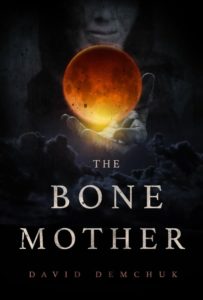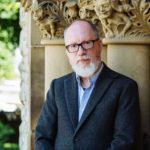
Writing the Unsaid and Forgotten: An Interview with David Demchuk
- Posted by Augur Blog
- On November 28, 2018
- 0 Comments
- author interview, david demchuk, sunburst award
Playwright turned author David Demchuk hit it out of the park with his debut horror novel, The Bone Mother. Published in 2017, the novel garnered a lot of praise from readers and critics alike. It was the first horror novel to be nominated for the Scotiabank Giller Prize. More recently, The Bone Mother won the 2018 Sunburst Award in the adult novel category.
Augur chatted with David over e-mail about The Bone Mother‘s beginnings, writing queerness, and the connection between horror and memory. And don’t miss his list of recommended authors at the end! You’re going to want to put them on your TBR list.

Easy question first! How did you become a storyteller?
I’m sure my family rued the day I learned to talk because from that moment I was incessant. However, my mother quickly found that one way to quiet me was to read to me—and the longer and more fantastic the stories, the better. She, herself, was fond of classic children’s stories, and sometimes would read us favourites from her youth, as well. This fed my already vivid imagination, and helped develop a sense of structure and a love of language from an early age.
You have an established career as a playwright. What made you explore the story of The Bone Mother in novel form?
I actually began the story as a play, titled The Thimble Factory (said factory plays a prominent role in the lives of a number of characters throughout this book). It was presented as a series of 13 short monologues performed by five actors of varying ages, genders and races, with the corresponding archival portraits projected behind them. However, I sensed as I worked on the play that it could succeed as a novel—albeit one with an unusual form—with some additional material and a bit of restructuring.
Do you find that either form lends itself more to certain stories?
While both forms require strong voices and distinctive characters, plays are much shorter, are physical and visual as well as verbal, and are presented in real-time to an audience that must be actively engaged for the duration. There is a sense of ritual in theatre, of a shared journey and a collective experience. A novel is most often read and experienced individually, and uses description and detail to give a sense of immersion into the work. A novel engages a reader at a different level than a play does its audience, makes different demands and allows for resting, rereading and revisiting. A book is also an object, something that intrigued me throughout the publication of The Bone Mother and which is central to the creation of my new book. He said vaguely…
In The Bone Mother, why did you choose the horror genre to peer into the past?
Much of my writing is concerned with the past—with faltering memories, forgotten or misinterpreted or incompletely understood events, long-buried tragedy or trauma and the legacy that it can leave for future generations. I have a long-time love of horror as a genre, but because it’s not a well-regarded genre for the stage I had not had many opportunities to embrace it fully in my work. The Bone Mother was my first real chance to bring together the themes that most interest me and the genre that is closest to my heart.
The structure of The Bone Mother has been described as a mosaic of interconnected short stories. What made you choose this structure over a typical point A to point B novel?
As I started the project, I had in my mind that I wanted to draw on my father’s Ukrainian heritage, to explore the legends and folklore of Eastern Europe—some of which are a part of popular culture (through vampires and werewolves, primarily) but many of which are unknown to North American readers. I wanted to write the piece for performance as a series of monologues, as these have always been one of my greater strengths. I knew that I wanted each character to appear once, but that many of the characters would somehow be connected to each other and to an overarching narrative thread.
And I wanted to try working with photographs as prompts—ideally photographs that were in the public domain or licensed through Creative Commons—and that was how I discovered the work of Costica Acsinte. From the hundreds of photographs in his archive, I selected about 20 that I felt a strong connection with. After I had written the first five or six pieces, I realized that something unusual and powerful was happening—and that my job was to set that realization aside and just keep going. And it was then that I saw how the project, with some adjustment, could be a novel as well as a performance, and I kept that in the back of my mind as I worked.
Erasure and forgetting underlie the breadth of the book. What drew you to those themes?
As a queer man who came of age at the start of the HIV/AIDS crisis, I was witness to the loss of a generation of queer men and trans people. Of essential voices and creators and mentors in our communities: of the history that they had lived, the work that they had created, the sex and love that had bound them together, and the futures that they had fought for. It echoed the loss, and frankly the extermination, of other marginalized and denigrated communities throughout history, across cultures and around the world—some of which I knew had happened in Eastern Europe, including the country where my father was born. I have always been drawn to these themes, and I expect I always will be.
What role does movchanya (silence)—and the unsaid in general—play in The Bone Mother?
In The Bone Mother, the “silence” known as movchanya is a literal curse. A curse of infertility, miscarriage and stillbirth that imperils a traditional conservative farming community, so much so that their social mores are fractured, and previously unspoken identities and relationships emerge as a means for the community’s survival.
Many times throughout the book, characters are compelled to stay silent to save themselves, or to save others at their own expense, and that silence often has painful consequences. To me, someone who is a communicator and a lover of language, silence works in tandem with secrecy and falsehood as a tool of manipulation and oppression: at the family level, the community level, the national level and the global level. Identities concealed, warnings not given, love not expressed, stories not told.
Queer characters like Lena and Alice appear next to mythical creatures. Why is that and what is your approach to writing queerness?
Queerness and monstrosity have long been linked in horror as a genre, many times with monstrosity presented as a metaphor for the queer identity and queer experience (sometimes sympathetically, with ‘tragic’ monsters who cannot control their urges—but most often as a way to further vilify us). It was important to me from the beginning to ensure that queer and trans characters were part of The Bone Mother’s mosaic of stories. And to not confine them to simple categories like “heroes,” “villains” or “victims.” Or, for that matter, ‘“humans” or “monsters.”
The stories of Borys, Katerina, Krisztina, Lorincz, Andreas, Gregor, Sabina, Horia, Ivan, Nadiya and Lena all have elements of queerness in them. In many of these stories, queerness is linked to transformation (for better or worse) or the unveiling of a gift or a secret power. I suppose that says a lot about how I see queerness—the aspects of it that I celebrate and also those that frighten and unsettle me.
I was charmed by the Sesame Street story where Grover warns us about “the monster at the end of this book,” only to reveal at the end that he, himself, is the monster. Ultimately, the monsters I create are an extension of myself, a provocation to my personal fears, and an expression of my darkest desires. The monster at the end of my book is me.
Are there writers, established or new, you would love to have more people read?
From Canada, I would suggest Gemma Files, Michael Rowe, Helen Marshall, Nathan Niigan Noodin Adler, my fellow Sunburst Award winners Cherie Dimaline and Sandra Kasturi, Nalo Hopkinson, Fonda Lee, Silvia Moreno-Garcia, Kate Heartfield, Emily Carroll, Kate Story, Matt Moore, Iain Reid, and David Nickle.
Internationally, I encourage everyone to read Daniel Ortberg, Carmen Maria Machado, Gretchen Felker-Martin, Indra Das, Hye-young Pyun, Sara Gran, Samanta Schweblin, Jac Jemc, Andrew Michael Hurley, Sarah Waters, Susan Hill, Sarah Pinborough, Mike Carey, and the many anthologies edited by Ellen Datlow—but in particular, her Year’s Best Horror series.
This is a great time to reread The Haunting of Hill House by Shirley Jackson, Frankenstein by Mary Shelley, Random Acts of Senseless Violence by Jack Womack, and Kindred by Octavia Butler. The graphic novel adaptation of Kindred is stunning.

David has a special interest in queerness and monstrosity. His Cabbagetown backyard is home to a hive of curious but quick-tempered bees. He is quietly at work on a troubling new novel. Visit David’s website to find out more about his work. You can also find him on Twitter @david_demchuk.
LOVE THIS POST?
Help Augur grow by participating in our Subscription Drive! We’re looking for 75 new subscriptions by November 30. Click the banner below to see the perks & discounts we’re offering!





0 Comments